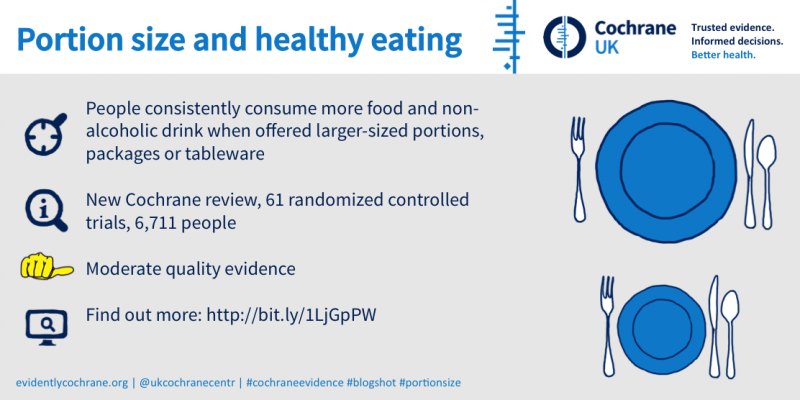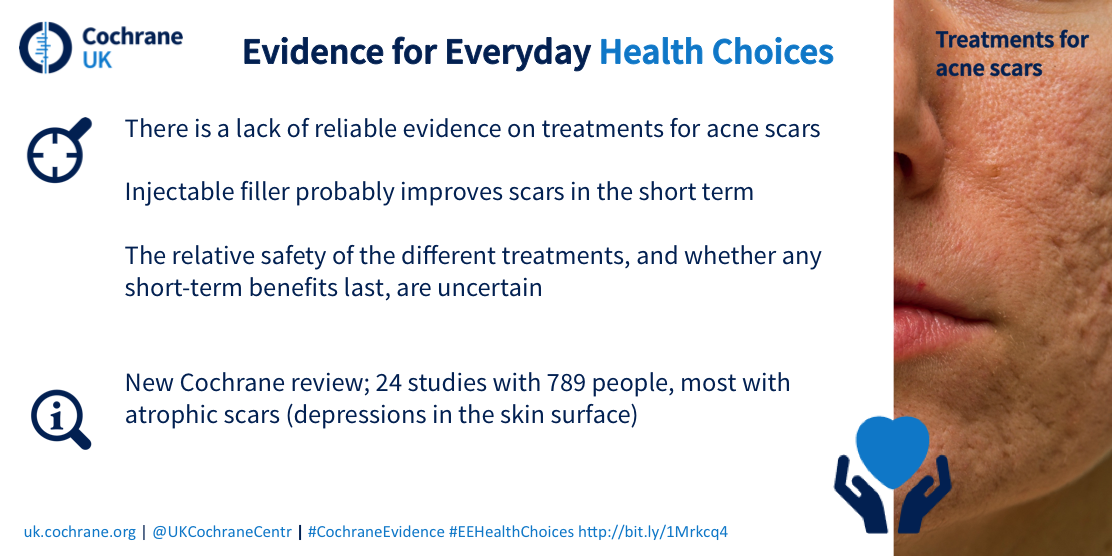

Sarah Chapman is a knowledge broker at Cochrane UK. She writes and edits their weekly blog, Evidently Cochrane, and helps to shares Cochrane evidence across social media platforms.
It’s nine months since we started experimenting with blogshots as a way to share evidence. You can read more about how we developed them in this blog post: http://www.evidentlycochrane.net/blogshots-evidence-at-a-glance/
These images with brief information, shared though social media, are proving to be really popular. I’m noticing more pictures in my Twitter feed and blogshots fit with this increased appetite for images. They also provide useful information fast. People share them, comment on them and many click the accompanying link to the review (or blog, or other resource). Our most popular so far have been the blogshots accompanying the portion size review, which quickly generated more than 1000 clicks to the review.

It’s fantastic that others in Cochrane are translating our blogshots or looking to make their own and now seems like a good time to bring you up to date with how we’re making and using blogshots and to offer a few tips, in the hope that this will encourage you to blogshot (new verb!) your reviews!
What to put into a blogshot?
- Image:
 Something clear and simple, which will allow the title to show up. It's also worth considering the impact images have. It can be hard finding what I consider to be truthful images when selecting from a library of stock images, but worth taking some time over. Choose well and they can get the blogshot noticed and reinforce the written information; get it wrong and they can mislead, annoy or even make people feel judged. It's particularly challenging, and emotive, with subjects like mental health conditions. Searching related terms brings up numerous photos of people tearing at their hair or making exaggerated expressions. I chose the image on the right for a blogshot on panic disorder, which I hoped was both more respectful and more truthful. Please contact Muriah Umoquit in the Communications and External Affairs department. She can help get you an appropriate images, at no cost to your group.
Something clear and simple, which will allow the title to show up. It's also worth considering the impact images have. It can be hard finding what I consider to be truthful images when selecting from a library of stock images, but worth taking some time over. Choose well and they can get the blogshot noticed and reinforce the written information; get it wrong and they can mislead, annoy or even make people feel judged. It's particularly challenging, and emotive, with subjects like mental health conditions. Searching related terms brings up numerous photos of people tearing at their hair or making exaggerated expressions. I chose the image on the right for a blogshot on panic disorder, which I hoped was both more respectful and more truthful. Please contact Muriah Umoquit in the Communications and External Affairs department. She can help get you an appropriate images, at no cost to your group. - Title: Short and simple.
- Key message: share one or more pieces of information from the review. I put the key message(s) before the information about the review, having had feedback that people want to read this first. In line with work done by Clare Glenton and colleagues, I use the qualifiers ‘probably’ and ‘may’ for moderate and low GRADE ratings, and ‘unknown’/’uncertain’ for very low quality evidence. (More about GRADE in a moment).
- Information about the review: I always say it’s a Cochrane review (you could add ‘New’ or ‘Updated’) and give the number of studies and participants. For blogshots aimed at a lay audience (our Evidence for Everyday Health Choices series), I use ‘studies’ rather than specifying the study design, as the latter is meaningless to many and doesn’t tell people much. I may give some brief information about population/intervention/comparator/outcomes.
- Quality of evidence/GRADE? We recently reviewed our decision to use only reviews with GRADE for blogshots, knowing that this means we are missing out on sharing evidence from many reviews in this popular format. We have decided to stick with this, as GRADE helps me to prepare an accurate evidence summary, in a short time, using consistent phrasing (as outlined above). However, we have left out any explicit reference to GRADE or evidence quality in the Everyday Health Choices blogshots and will now extend this to all our blogshots. The majority of readers will not be familiar with GRADE and we feel it is more helpful to use it only to inform our key messages.
- The all-important link: It is vital to share a link to the review, or other related material, in the tweet or other post along with the blogshot. We make a bit.ly link for each blogshot, which allows us to see how many clicks it’s generated, a simple measure of the success of the blogshot. We had been giving this within the image too (the ‘find out more’ bit), but have decided to abandon this as it’s not clickable and just clutters the space. However, we will put it at the bottom, along with the hashtags, to help us keep track of which link belongs to the blogshot.
One review, more than one blogshot?
This is definitely worth considering, where there are multiple key messages to share (we made four for the portion size review, each with the same link but a different message) or where you wish to target more than one audience.
We make blogshots in our general template but also for each of our ‘Evidence for Everyday’ series, for nurses, midwives, patients and (from this June) Allied Health Professionals. You could consider dual blogshots for health professionals and patients, perhaps, and distinguish between them using a different coloured title, as well as tailoring the language and detail for each target audience. Here are some examples to show you how you can change of the look of the template:


Where to share?
We share our blogshots on Twitter and Facebook; Pinterest, where we have created boards for each series, and our Cochrane UK website, where they are archived by category and available for anyone to download. We have also just started to post them on the image-sharing social media channel Instagram, using an adapted square template.
Each social media channel has its own advantages and audiences. Instagram tends to be used to 'humanise' a brand, showing that there are people working behind the company logo. It is also increasingly it is being used for information dissemination and campaigning. The WHO use it to deliver information cards with campaigning hashtags. We are doing something similar.
We will post the square blogshots along with photos of events to increase our brand reach across social media and target a new audience away from twitter and facebook.
Tempted to make your own?
We are very happy for you to suggest reviews you think would make good blogshots, but making them yourself is easy and something you might want to consider.
Blogshot templates in each Cochrane Community colour are available for you to download here. Once you have the template you just need to plug in your logo, picture, and text.
The template is a starting point, but some of the decisions you make about what to share may differ from ours. We are learning as we go and expect to make changes according to what we learn along the way.
We’re looking forward to seeing how our Cochrane colleagues adopt and adapt this popular format!
Sarah Chapman
Knowledge Broker, Cochrane UK

